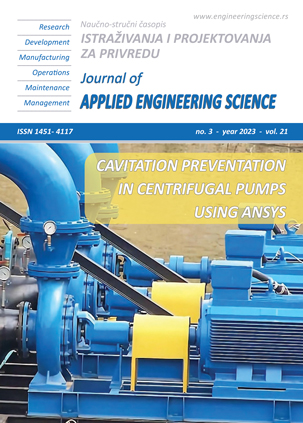INFLUENCE OF FIBER LENGTH AND MOISTURE CONTENT ON SOUND AND VIBRATION CHARACTERISTICS OF HEMP/EPOXY COMPOSITES
Abstract
Bio-composites have become increasingly popular as a substitute for synthetic fibers over the last decade due to their eco-friendly nature. To utilize them effectively in engineering applications, particularly in the automotive industry, a thorough understanding of the material properties is necessary. This experimental investigation focuses on exploring the vibration-damping and acoustic properties of fiber composites made from hemp natural fiber and epoxy resin. The study involved the preparation of composite specimens using both short and long fibers through a hand layup process. The natural frequency and damping ratio of the specimen were computed from time-domain experimental data. The sound absorption coefficient of fiber specimens was determined in the frequency range of 63 Hz to 6300 Hz by using the impedance tube technique. The analysis revealed that the pre-treatment of fiber and the use of long fiber rather than short fiber enhances the damping properties of hemp fiber composites. Immersion of specimens in water resulted in the degradation of damping properties. Acoustic tests clearly showed that the ageing process affected short-treated fiber composites more significantly when compared to long-treated fiber composites.
References
lang=EN-US>ADDIN
Mendeley Bibliography CSL_BIBLIOGRAPHY Di Landro L, Janszen G.(2014) Composites with hemp reinforcement and bio-based epoxy matrix. Compos Part B Eng; 67:220–6. doi:10.1016/j.compositesb.2014.07.021.
Liu M, Thygesen A, Summerscales J, Meyer AS. (2017). Targeted pre-treatment of hemp bast fibers for optimal performance in biocomposite materials: A review. Ind Crops Prod; 108:660–83. doi:10.1016/j.indcrop.2017.07.027.
Carvalho H, Salman H, Leite M. (2018). Natural Fiber Composites and Their Applications : A Review:1–20. doi:10.3390/jcs2040066.
Pracella M, Chionna D, Anguillesi I, Kulinski Z, Piorkowska E.(2006). Functionalization, compatibilization and properties of polypropylene composites with Hemp fibers. Compos Sci Technol; 66:2218–30. doi:10.1016/j.compscitech.2005.12.006.
Assarar M, Scida D, Zouari W, Saidane EH, Ayad R. (2016). Acoustic emission characterization of damage in short hemp-fiber-reinforced polypropylene composites. Polym Compos; 37:1101–12. doi:10.1002/pc.23272.
Li X, Tabil LG, Panigrahi S. (2007). Chemical treatments of natural fiber for use in natural fiber-reinforced composites: A review. J Polym Environ; 15:25–33. doi:10.1007/s10924-006-0042-3.
Shahzad A. (2011). Effects of fiber surface treatments on mechanical properties of hemp fiber composites. Compos Interfaces;18:737–54. doi:10.1163/156855412X629583.
Abdullah AH, Azharia A, Salleh FM. (2015). Sound absorption coefficient of natural fibers hybrid reinforced polyester composites. J Teknol;76:31–6. doi:10.11113/jt.v76.5643.
Kabir MM, Wang H, Lau KT, Cardona F, Aravinthan T. (2012). Mechanical properties of chemically-treated hemp fiber reinforced sandwich composites. Compos Part B Eng;43:159–69. doi:10.1016/j.compositesb.2011.06.003.
Shaid Sujon MA, Islam A, Nadimpalli VK. (2021). Damping and sound absorption properties of polymer matrix composites: A review. Polym Test;104:107388. doi:10.1016/j.polymertesting.2021.107388.
Seddeq HS, Aly NM, Marwa A A, Elshakankery MH.(2013). Investigation on sound absorption properties for recycled fibrous materials. J Ind Text;43:56–73. doi:10.1177/1528083712446956.
Aziz SH, Ansell MP. (2004). The effect of alkalization and fiber alignment on the mechanical and thermal properties of kenaf and hemp bast fiber composites: Part 1 - polyester resin matrix. Compos Sci Technol ;64:1219–30. doi:10.1016/j.compscitech.2003.10.001.
Placet V. (2009) Characterization of the thermo-mechanical behaviour of Hemp fibers intended for the manufacturing of high performance composites. Compos Part A Appl Sci Manuf;40:1111–8. doi:10.1016/j.compositesa.2009.04.031.
Kumar DR, Vishnuvardhan R, Rahul R.(2019). Experiment on acoustic and vibration damping properties of natural fiber reinforced composites. Int J Recent Technol Eng;8:262–4.
Taban E, Khavanin A, Jafari AJ, Faridan M, Tabrizi AK. (2019). Experimental and mathematical survey of sound absorption performance of date palm fibers. Heliyon;5:e01977. doi:10.1016/j.heliyon.2019.e01977.
Niresh J, Neelakrishna S, Subharan S, Prabhakaran R. (2015). Performance Testing for Sound Absorption Coefficient by Using Impedance Tube. Res J Appl Sci Eng Technol;11:185–9. doi:10.19026/rjaset.11.1706.
Mahmoudi S, Kervoelen A, Robin G, Duigou L, Daya EM, Cadou JM. (2019). Experimental and numerical investigation of the damping of flax–epoxy composite plates. Compos Struct;208:426–33. doi:10.1016/j.compstruct.2018.10.030.
SathishKumar G, Chandrasekaran M, Vinod Kumar T, Vivek P. (2018). Vibration and damping characteristics of sisal and glass fiber reinforced polyester composite. Int J Eng Technol;7:503–9. doi:10.14419/ijet.v7i2.33.14820.
Pavan A, Dayananda P, Vijaya KM, Hegde S, Narampady Hosagade P. (2019). Influence of seawater absorption on vibrational and tensile characteristics of quasi-isotropic glass/epoxy composites. J Mater Res Technol;8:1427–33. doi:10.1016/j.jmrt.2018.10.008.
"Arial",sans-serif;mso-fareast-font-family:"Times New Roman";mso-bidi-font-family:
"Times New Roman";mso-ansi-language:EN-US;mso-fareast-language:EN-US;
mso-bidi-language:AR-SA'>
Fairlie G, Njuguna J. (2020).Damping properties of flax/carbon hybrid epoxy/fiber-reinforced composites for automotive semi-structural applications. Fibers;8:1–15. doi:10.3390/fib8100064.

